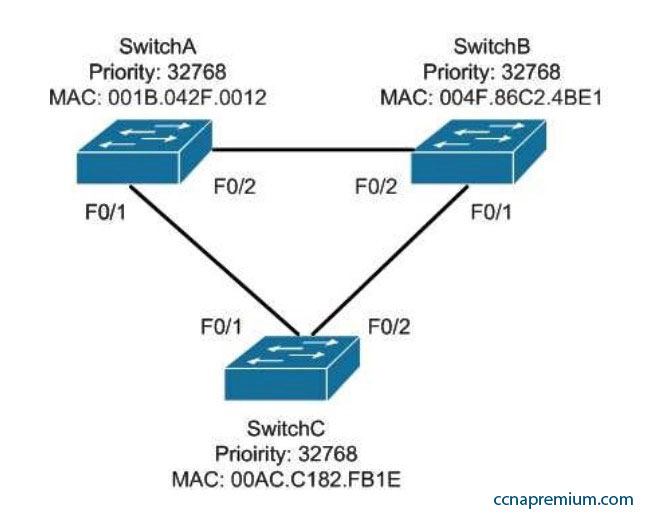View the following network diagram:

Which switch will become the root bridge?
A. SwitchA
B. SwitchB
C. SwitchC
D. The root bridge cannot be determined from the given information.
Correct Answers: A
Explanation:
SwitchA will become the root bridge. The bridge ID, also known as the switch ID, is used to elect the root bridge in a redundant network topology. The bridge ID has two components:
– Switch’s priority number: Configured as 32768 on Cisco switches by default
– Switch’s Media Access Control (MAC) address: The burnt-in hardware address of the network interface card
The switch with the lowest bridge ID is selected as the root bridge. If the same priority number is configured on two or more switches in the network, the switch with the lowest MAC address will become the root. Bridge Protocol Data Units (BPDUs) communicate the details of the switch with the lowest bridge ID in the network. The election process for the root bridge takes place every time there is a topology change in the network. A topology change may occur due to the failure of a root bridge or the addition of a new switch in the network. The root bridge originates BPDUs every two seconds, which are propagated by other switches throughout the network. BPDUs are used as keepalives between switches, and if a switch stops receiving BPDUs from a neighboring switch for ten intervals (20 seconds), it will assume a designated role for the network segment.
Neither SwitchB nor SwitchC will become the root bridge. Although both have an equal priority value to SwitchA (32768), the MAC addresses of SwitchB and SwitchC are higher than that of SwitchA.
The root bridge can be determined with the information given. If the diagram did not indicate MAC addresses, then the root bridge would not be able to be determined, since the priorities are equal.